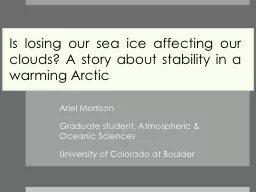

Graduate student Atmospheric amp Oceanic Sciences University of Colorado at Boulder Is losing our sea ice affecting our clouds A story about stability in a warming Arctic Motivating questions ID: 240696
Download Presentation The PPT/PDF document "Ariel Morrison" is the property of its rightful owner. Permission is granted to download and print the materials on this web site for personal, non-commercial use only, and to display it on your personal computer provided you do not modify the materials and that you retain all copyright notices contained in the materials. By downloading content from our website, you accept the terms of this agreement.
Slide1
Ariel Morrison Graduate student, Atmospheric & Oceanic Sciences University of Colorado at Boulder
Is losing our sea ice affecting our clouds? A story about stability in a warming ArcticSlide2
Motivating questionsDoes atmospheric stability control Arctic clouds?What are the most important process relationships between clouds, atmospheric circulation, and sea ice concentration?
What are the relative controls from large- and regional-scale processes?Where should this work go in the future?Slide3
DataAll monthly means 2006-07 – 2013-12 GOCCP – CALIPSO cloud fraction and phaseAIRS – temperature profiles (near surface stability)
ERA-Interim – sea level pressureHadISST – sea ice concentrationCERES-EBAF – TOA net radiationSlide4
First approachStrategy:Look at annual means for geographic distributionSlide5
How does stability vary across the Arctic?
Kay and
L’Ecuyer
2013Slide6
<
6K
Annual mean – same geographic region has low stability, SLP, SIC, and high cloud fractionSlide7
What controls clouds in the stable regime?
Region of fastest sea ice loss!
Sea ice concentration trends 1979-2014Slide8
Next approachStrategy:Assess relationships between variables with
scatterplots of monthly means in the stable regime“Time-independent” relationships
>6KSlide9
Low stability = large cloud fractionHigh stability = large range of cloud fractionSlide10
Cloudiest unstable points = open oceanSlide11
Initial results
Annual mean geographic variations = two distinct regions
Within stable regime:
Low stability = always more clouds?
High stability = large range in cloud fraction – why?
Arctic cloud controlled by both atmosphere and surfaceSlide12
Goals and future work
Add more data, eg. optical depth, precipitation, boundary layer depth
More conditioning to assess process relationships
Look at seasonality of process relationships using TOA net radiation
Suggestions welcome!Slide13
Open ocean in the stable regimeSlide14
High stability, varied cloud fraction = air heated by solar radiation or advectionSlide15